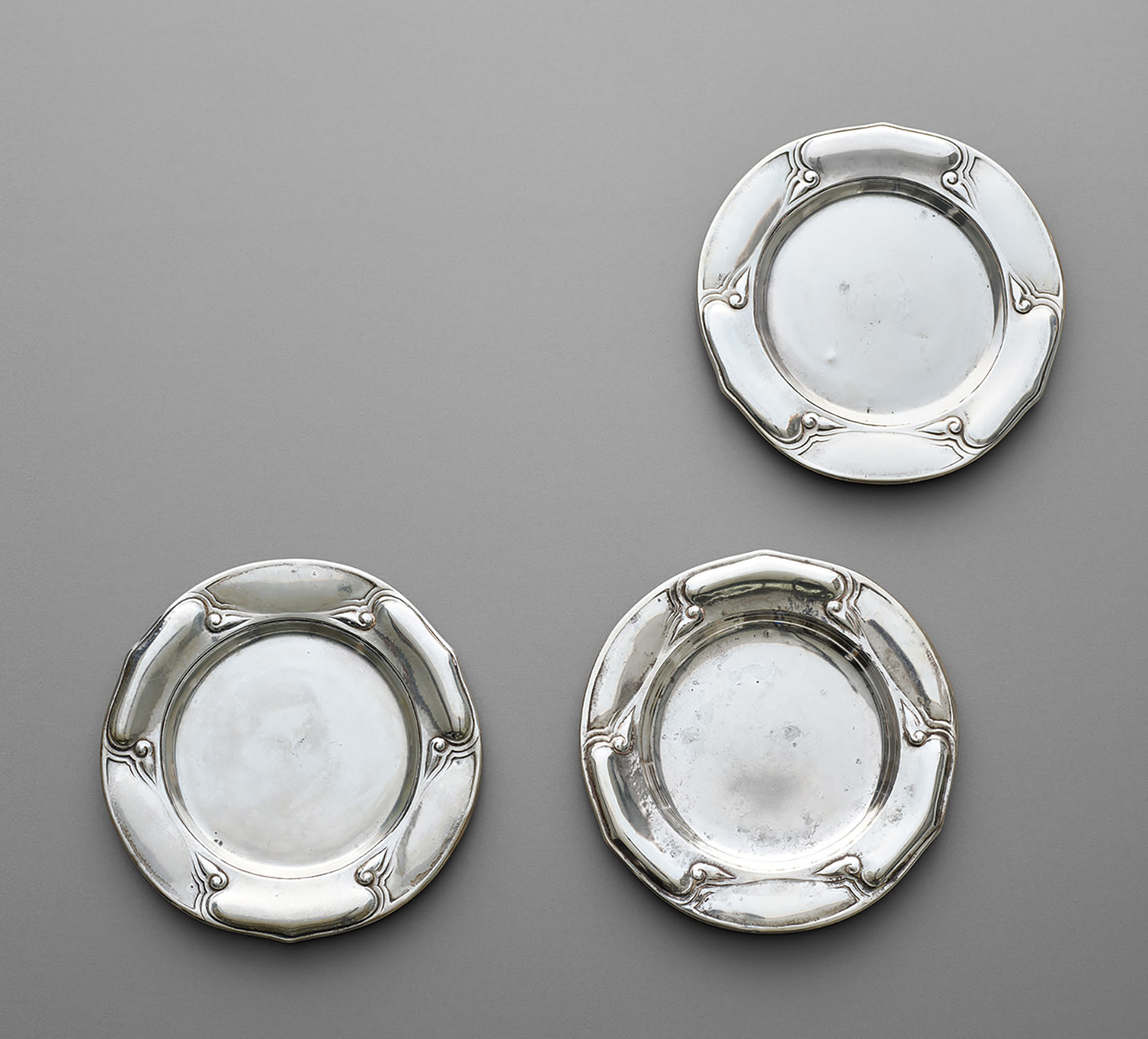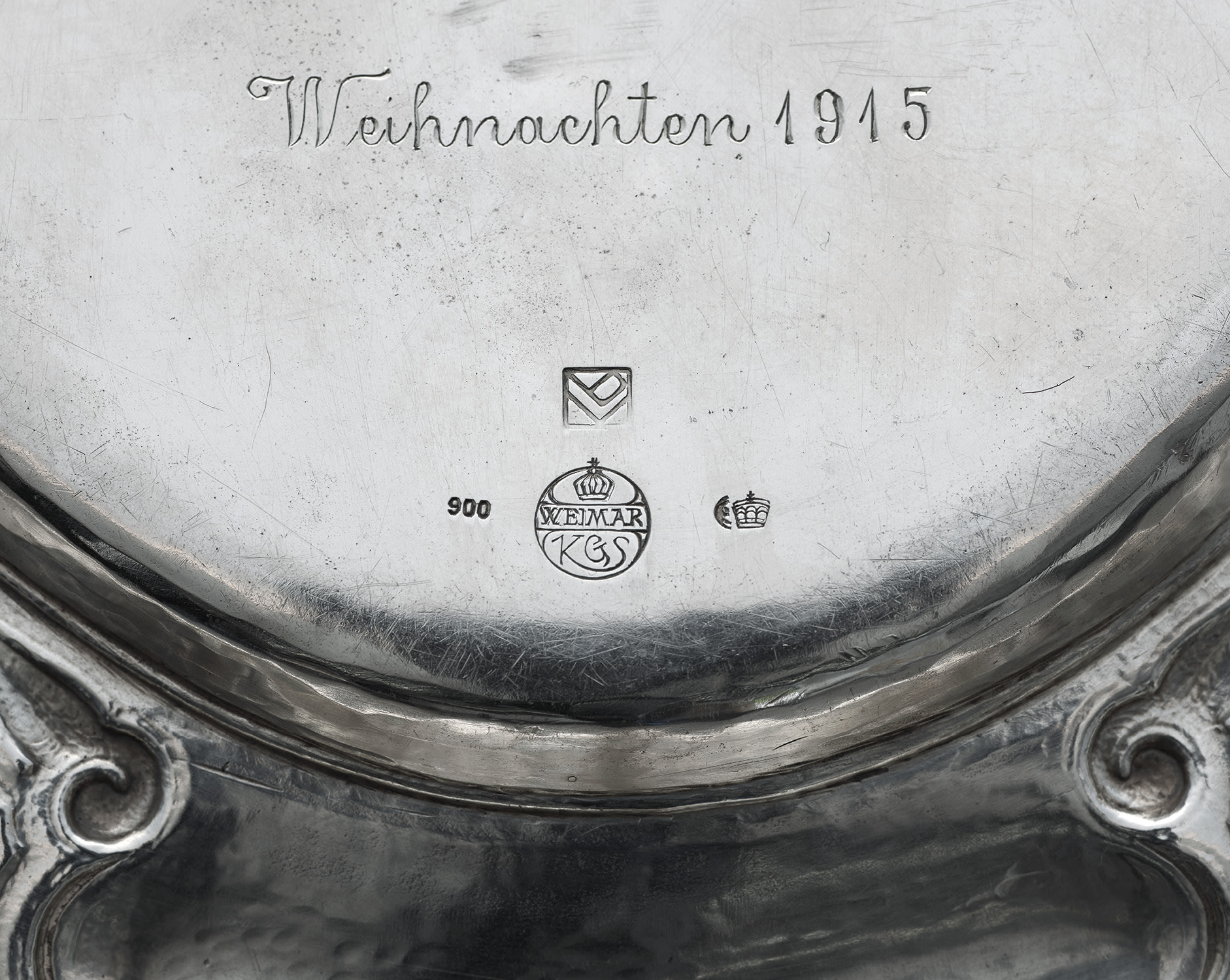





63
Henry van de Velde
Three plates
circa 1915
Precious metal.
Each: 19.8 cm (7 3/4 in.) diameter
Reverse of each impressed with purity mark 900, crescent and crown mark. Two further impressed with artist's private studio mark and Grand Ducal Saxon School of Arts and Crafts, Weimar mark and incised 24. November 1915 and Weihnachten 1915, respectively.
Full-Cataloguing
Phillips wishes to thank Dr. Thomas Föhl from the Klassik Stiftung Weimar for his assistance cataloguing the present lot.
Three Silver Plates by Henry van de Velde
By Thomas Föhl
The design of the present set of three plates undoubtedly traces back to the Belgian architect and designer Henry van de Velde. His estate holds a drawing illustrating a comparable design, noted with almost identical dimensions (Wvz Vol. I; No. I.2.128). The hallmarks also indicate this authorship and confirm the present plates were executed at van de Velde’s School of Applied Arts in Weimar, rather than produced by the Weimar court jeweller Theodor Müller, who was commonly responsible for the production of his silverwork. Since 1911, van de Velde’s second private studio mark, set as a square ‘vdV’ over the hallmark of the School of Applied Arts, has occasionally been used in this form and it is thought the mark was probably used exclusively by the silversmith Albert Feinauer.
The story behind this ‘silver gift’ is also of interest as it leads us to the provenance of the present lot, which originally belonged to the Counts of Douglas. The family was closely connected with van de Velde, having commissioned the designer in 1897 to develop a comprehensive advertising strategy for their newly founded company ‘Tropon’, which included the design of a logo and packaging, printed advertisement in addition to the office furnishings. This first example of commercial corporate identity, often cited in literature, was conceived by Count Angus Douglas (1870-1938), together with his friend Baron Eberhard von Bodenhausen (1868-1918), who had met as students.
In 1898, Count Douglas married Margarete von Enckefort (1878-1938), with whom he had three daughters and a son. In 1912, he inherited a summer residence in Ralswiek, an opulent castle built in 1893 on the island of Rügen. Following which, Count Douglas entrusted van de Velde with the complete refitting and extension of the residence, completed in 1916.
The chairman of the supervisory board of Krupp in Essen, then Europe's biggest armaments company, Baron Bodenhausen, held doctorates in both law and art history, and was a loyal patron of van de Velde. After 1912, he had a brief love affair with Countess Margarete Douglas, during which time van de Velde played the Postillon d'Amour, exchanging letters and delivering gifts on his many trips to Ralswiek.
The present set of three silver plates from 1915 was most likely sent by Baron Bodenhausen to Ralswiek as birthday and Christmas presents. The date of ‘November 24, 1915’ engraved on the reverse of one of the plates is of significance as it corresponds to the birthday of the young Countess Anga Douglas (1900-1976). Coincidentally in 1925, Anga married the only son of her mother's former lover. The gift was reciprocated in mid-December 1915, when Margarete von Douglas sent her own ‘silver gifts’ to her lover. This gift is referenced in a letter dated 16 December 1915 from van de Velde to Baron Bodenhausen, in which he complained that the two works still required some reworking due to the urgency of the request.
Given the undoubted authorship, we may record the Douglas family as the provenance of the present lot, in all probability having been gifted to the married Baroness Anga von Bodenhausen, née Countess Douglas.
Three Silver Plates by Henry van de Velde
By Thomas Föhl
The design of the present set of three plates undoubtedly traces back to the Belgian architect and designer Henry van de Velde. His estate holds a drawing illustrating a comparable design, noted with almost identical dimensions (Wvz Vol. I; No. I.2.128). The hallmarks also indicate this authorship and confirm the present plates were executed at van de Velde’s School of Applied Arts in Weimar, rather than produced by the Weimar court jeweller Theodor Müller, who was commonly responsible for the production of his silverwork. Since 1911, van de Velde’s second private studio mark, set as a square ‘vdV’ over the hallmark of the School of Applied Arts, has occasionally been used in this form and it is thought the mark was probably used exclusively by the silversmith Albert Feinauer.
The story behind this ‘silver gift’ is also of interest as it leads us to the provenance of the present lot, which originally belonged to the Counts of Douglas. The family was closely connected with van de Velde, having commissioned the designer in 1897 to develop a comprehensive advertising strategy for their newly founded company ‘Tropon’, which included the design of a logo and packaging, printed advertisement in addition to the office furnishings. This first example of commercial corporate identity, often cited in literature, was conceived by Count Angus Douglas (1870-1938), together with his friend Baron Eberhard von Bodenhausen (1868-1918), who had met as students.
In 1898, Count Douglas married Margarete von Enckefort (1878-1938), with whom he had three daughters and a son. In 1912, he inherited a summer residence in Ralswiek, an opulent castle built in 1893 on the island of Rügen. Following which, Count Douglas entrusted van de Velde with the complete refitting and extension of the residence, completed in 1916.
The chairman of the supervisory board of Krupp in Essen, then Europe's biggest armaments company, Baron Bodenhausen, held doctorates in both law and art history, and was a loyal patron of van de Velde. After 1912, he had a brief love affair with Countess Margarete Douglas, during which time van de Velde played the Postillon d'Amour, exchanging letters and delivering gifts on his many trips to Ralswiek.
The present set of three silver plates from 1915 was most likely sent by Baron Bodenhausen to Ralswiek as birthday and Christmas presents. The date of ‘November 24, 1915’ engraved on the reverse of one of the plates is of significance as it corresponds to the birthday of the young Countess Anga Douglas (1900-1976). Coincidentally in 1925, Anga married the only son of her mother's former lover. The gift was reciprocated in mid-December 1915, when Margarete von Douglas sent her own ‘silver gifts’ to her lover. This gift is referenced in a letter dated 16 December 1915 from van de Velde to Baron Bodenhausen, in which he complained that the two works still required some reworking due to the urgency of the request.
Given the undoubted authorship, we may record the Douglas family as the provenance of the present lot, in all probability having been gifted to the married Baroness Anga von Bodenhausen, née Countess Douglas.